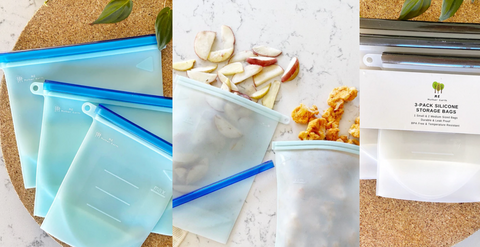
I’m about to age myself here. When I went to school just about nothing was exciting about September but getting to pick out a new lunch box. Did I want Barbie or I Dream of Jeanie? They always, and I mean always, had a weird smell that was part chemical and part stale food (even brand new, ugh, I’m smelling it now.) Any beverage kept in the “thermos” which may or may not have been made by Thermos, was lukewarm when time for consumption. Inside this intrepid school day staple was a sandwich, some fruit, and if your family was fancy, maybe a Twinkie or a bag of chips. Your pb & j and fruit - unless Mom was harsh and just tossed it in whole - was in a “baggy.”

Saran Wrap or polyvinylidene chloride had been commercialized since the 40’s and was also used for sandwiches, but I remember mine in a thin plastic envelope of sorts, with a flap that tucked in. The zipper topped kind were comparatively expensive, and again only for the fancy. They leaked if your tuna was juicy and did only a modest job of keeping your sandwich from drying out, but the best part of all was you just tossed them in the trash with your crusts and banana peel easy peasy. Not that your lunch box would smell any better for it.
It was another time. A really entitled and stupid time.
Plastic has been one of the most innovative human inventions since it all began in the late 1800’s. We keep thinking up new and exciting ways to manufacture and use it. It’s remarkable! Has so many foreseeable applications! Except, as usual, we failed to consider that one irritating little detail. What’s the end game?
Where does it finally… go? We all know the answer is no where. Every piece of plastic ever manufactured is still with us. On Mother Earth.
It’s past time to up our lunch game, so let’s talk about silicone. Silicone is made from natural materials (silica) that are exposed to high heat and so, yes, fossil fuels are used in its production. Bummer. But there are quite a few ways that silicone knocks plastic on its chemical butt. The first is that food grade silicone is inert - it will not react with food - and gives off no fumes when heated. It’s so temperature resistant that it can be taken from the freezer to the oven. Here’s the best part; silicone is so durable it can be reused near indefinitely. Being thicker it also reduces absorption of off-flavors or odors in frozen foods and can reduce freezer burn with the most minor of effort to get most air out of that bag. Did I say dishwasher safe?

Is it perfect? No. It’s no more biodegradable than plastic. It’s just as difficult to recycle. But it does not break down into microparticles and end up in the food chain. And because you can use it for a very long time before disposal, it will reduce waste going to landfills. Silicone bags are progress, not perfection, and that is the mantra of Me Mother Earth. Check out our bags here, here, and here.
Make lunch a little more friendly for the planet and maybe less smelly. Oh, and if you should find a Monkees lunch box in your garage, I may still be in the market. For old times sake.
TESTIMONIALS/REVIEWS DISCLAIMER
Plastic-Free Living Blog by Me Mother Earth may contain testimonials or reviews by contributor writers. These testimonials reflect the real life experiences and opinions of such users. However, the experiences are personal to those particular users, and may not necessarily be representative of all users of our products and/or services. We do not claim, and you should not assume, that all users will have the same experiences.
Me Mother Earth was created by Amanda Runkle and Alberto Gomes who aren’t experts, just two Mother Earth loving humans who share their plastic-free tips and advice with the help of contributor writers. The various DIY & zero waste methods, suggestions, and tutorials on Me Mother Earth are not error proof, they’re merely what worked for Amanda and Alberto along the way. Extra precautions and additional research are always advised and Me Mother Earth cannot be held responsible for your personal health or the outcomes from any of the articles shared on our Blog.

